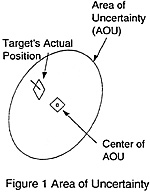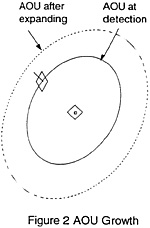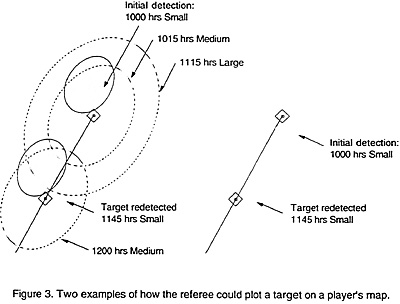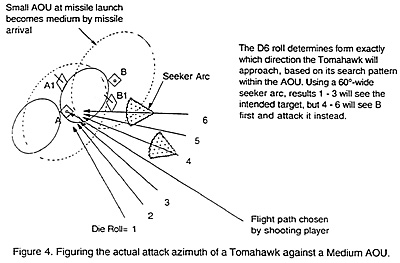Over the Horizon Targeting (OTH-T)
The picture that the Data Base Manager (DBM) sees is far different from those seen on the Harpoon table or for that matter the computer screen. First, its monochrome! Second, it's made up from several different sources via several different communication circuits. The most common Satellite Communications (SATCOMS) used by Tomahawk are Officer-in-Tactical Command Information-Exchange Subsystem (OTCIXS), Tactical-Data Information-Exchange Subsystem (TADIXS) and of course, NTDS. Over these circuits the DBM will receive targeting data in the form of a contact with an ID, Latitude/Longitude, an Area of Uncertainty, (AOU), what sensor detected the contact and when the detection occurred.
 An AOU is an ellipse measured in nautical miles along its semi-major and semi-minor axis, that has a high probability of containing the target (Figure 1). They exist because of inherent errors in navigation equipment and sensors. In game terms, VSmall and Small AOUs will be engageable and are usually taken from the firing platforms' own sensors or another unit which currently detects the target and is in direct communication with the firing platform. Since the seeker search patterns of most missiles are fairly limited in size, the larger the AOU becomes, the smaller the percentage of seeker coverage. Medium AOUs are still engageable but with a lower chance of acquiring the target. A large AOU cannot be engaged, but does give some idea of where to start looking for the enemy. Otherwise, it's of little use except to tell you there is an SS-N-19 shooter about to ruin your day! These usually come from national type sensors that triangulate on an emission.
An AOU is an ellipse measured in nautical miles along its semi-major and semi-minor axis, that has a high probability of containing the target (Figure 1). They exist because of inherent errors in navigation equipment and sensors. In game terms, VSmall and Small AOUs will be engageable and are usually taken from the firing platforms' own sensors or another unit which currently detects the target and is in direct communication with the firing platform. Since the seeker search patterns of most missiles are fairly limited in size, the larger the AOU becomes, the smaller the percentage of seeker coverage. Medium AOUs are still engageable but with a lower chance of acquiring the target. A large AOU cannot be engaged, but does give some idea of where to start looking for the enemy. Otherwise, it's of little use except to tell you there is an SS-N-19 shooter about to ruin your day! These usually come from national type sensors that triangulate on an emission.
The contact will also have a "Time Late" associated with it. For example, at 1200Z a P-3 makes contact with a North Korean Osa II, and it takes the operator 2 minutes to enter the contact and put it in his SATCOM transmission queue. Depending on the broadcast method, some units may not receive the datum for up to two hours. Since the Osa is moving, the AOU grows. Thus, a Small AOU will become a Large AOU if it is not updated by a new detection. At some point, if not updated, the AOU becomes unusable.
Lets Talk Engagement Planning
When directed by the Engagement Control Officer (ECO) to engage a contact, the operator, or Engagement Planner (EP) will select salvo size, Time of Search (TOS), search pattern, way points and the best approach to the target. By the way, there isn't a BOL option for surface-launched Tomahawk, though there is with sublaunched.
With waypoints you can make the Tomahawk come in from any direction, thus hiding your position. The TOS can be used by several shooters and have all their missiles engage the target at once, saturating your opponent's defenses. This will take a total of at least seven minutes, to enter the target if needed, make the plan up and print it. The ECO must then brief the plan to the Tactical Action Officer (TAO) and Commanding Officer, which is sometimes the most time-consuming part of the process!!
Searching the Target Area
 When the Tomahawk reaches the target's AOU, it does not immediately slam into the target. When the missile reaches the area it will begin a search pattern determined by the EP before launch. This could involve just going straight through the AOU if it's small enough, or weaving back and forth to cover a larger AOU. A group of targets may have overlapping AOUs that will provide the weapon with a choice of targets, (figure 2).
When the Tomahawk reaches the target's AOU, it does not immediately slam into the target. When the missile reaches the area it will begin a search pattern determined by the EP before launch. This could involve just going straight through the AOU if it's small enough, or weaving back and forth to cover a larger AOU. A group of targets may have overlapping AOUs that will provide the weapon with a choice of targets, (figure 2).
All SSMs are "equal opportunity, nondiscriminatory, high-resolution radar bullets," so whatever they see first, they will attempt to hit. But hey, at least you'll get one of them! (Its called "Iron in the water").
How to Ruin Someone's Day with a Greyhound (Tomahawk)
Rules, we don't need no stinking rules...
 Using AOUs in a game will require lots of work for the umpire. The initial size of an AOU depends on the sensor which detects it. (A radar or visual provides a VSmall AOU, detection of enemy communications provides a medium if less than 1000 nm or a large if greater than 1000 nm). He can put the target on the map and designate a VSmall, Small, Medium, or Large AOU (diagram #3). Using rule 6.6.5 Bearing only Launch (BOL): .....Searching a box 30 degrees to either side of the line of flight" . . . and averaging the speed of a Tomahawk (4-0) and SS-N-19 (12.0) from table D,
that being 16 nm per minute, the following can be extrapolated. VSmall AOUs are 5 nm by 5 nm, Small 15 nm by 15 nm, Medium 30 nm by 30 nm, and Large are 60 nm by 60 nm AOU's will grow at the following rate, VSmall to Small 15 minutes. Small to Medium 30 minutes. Medium to Large 1 hour.
Large AOU's will just keep growing.
Using AOUs in a game will require lots of work for the umpire. The initial size of an AOU depends on the sensor which detects it. (A radar or visual provides a VSmall AOU, detection of enemy communications provides a medium if less than 1000 nm or a large if greater than 1000 nm). He can put the target on the map and designate a VSmall, Small, Medium, or Large AOU (diagram #3). Using rule 6.6.5 Bearing only Launch (BOL): .....Searching a box 30 degrees to either side of the line of flight" . . . and averaging the speed of a Tomahawk (4-0) and SS-N-19 (12.0) from table D,
that being 16 nm per minute, the following can be extrapolated. VSmall AOUs are 5 nm by 5 nm, Small 15 nm by 15 nm, Medium 30 nm by 30 nm, and Large are 60 nm by 60 nm AOU's will grow at the following rate, VSmall to Small 15 minutes. Small to Medium 30 minutes. Medium to Large 1 hour.
Large AOU's will just keep growing.
The Engagement Plan
For Tomahawk, it should take roughly 15 minutes. This is not the minimum that a Tomahawk can be launched but takes into account all the steps during the engagement plan and requesting batteries released. For Harpoon, we could take it down to roughly 5 minutes. (Sorry, there is no "reaction fire").
Searching the Target area
 While the missile is enroute to the target area, all AOUs will grow to one size larger than what they were at launch (i.e., Small becomes Medium, Medium becomes Large, etc.). For our purposes, only the TARGET AOU is considered, since it is the only one which will affect seeker pattern size. What matters here is not where we think the enemy ships are, but where the missile believes its target is, compared to where the enemy ships really are (the "ground truth"). When the missile seeker turns on, it may acquire either target A or B, depending on which one it sees first. (See figure 4).
While the missile is enroute to the target area, all AOUs will grow to one size larger than what they were at launch (i.e., Small becomes Medium, Medium becomes Large, etc.). For our purposes, only the TARGET AOU is considered, since it is the only one which will affect seeker pattern size. What matters here is not where we think the enemy ships are, but where the missile believes its target is, compared to where the enemy ships really are (the "ground truth"). When the missile seeker turns on, it may acquire either target A or B, depending on which one it sees first. (See figure 4).
Determining which ship is the missile sees first is easy for all SSMs except TASM: The defending player places his ships on the table according to his previously specified formation. The referee marks the edge of the target's AOU nearest the missile, which now denotes the seeker turn-on point.
Whichever ship is closest to the missile and within the missile's forward ±30 degree arc is acquired. This is an exception to the DIO rule in 6.6.5 (BOL). ASCM/SSM combat occurs normally from that point on.
TASMs are different because they are the one SSM which conducts an autonomous search of the target's AOU. To simulate this, we randomly determine the actual attack azimuth, based on the launching player's intended attack azimuth and then altering it. If the TOS AOU is
- VSmall, roll D6: evens offset the azimuth 10 degrees clockwise (CW), odds offset 10 degrees counter-clockwise (CCW).
- Small, roll D6: 1 is 30 degrees CW, 2 is 20 degrees CW, 3 is 10 degrees CW, 4 is 10 degrees CCW, 5 is 20 degrees CCW, 6 is 30 degrees CCW (diagram #4).
- Medium, roll D12: 1 is 60 degrees CW, 2 is 50 degrees CW, 3 is 40 degrees CW, 4 is 30 degrees CW, 5 is 20 degrees CW, 6 is 10 degrees CW, 7 is 10 degrees CCW, 8 is 20 degrees CCW, 9 is 30 degrees CCW, 10 is 40 degrees CCW, 11 is 50 degrees CCW and 12 is 60 degrees CCW.
The missile is then placed on the table at the correct position relative to the target, and it picks its target as explained above.
The missile's attack azimuth is determined in reference to the intended target, although the missile may be detected by another unit in the area, and therefore placed on the table outside the normal detection range of the target unit. For example in figure 4, unit B may detect and incoming missile first, depending on the D6 azimuth roll.
Editors note. Thanks to FCC Kurt Kalbfleisch and FCC Andy Dory for sharing some of their knowledge with us. Both are active Navy. Kurt is stationed at Fleet Combat Training Center Pacific in San Diego and Andy is on USS Russell (DDG-59). It's not often we can get such qualified people to share what they know. This article was cleared for publication by the US Navy.
While this is not an official rules change to Harpoon, I will be working on ways to add this concept to the game, based on this and other sources.
The following are official rules Changes: SSMs may not be fired in the reaction fire phase, in BOL or any other mode. Tomahawk Antiship Missiles (TASMs) take 4+D6 minutes to prepare for firing, once a target is assigned.
BT
Back to The Naval Sitrep #2 Table of Contents
Back to Naval Sitrep List of Issues
Back to MagWeb Master Magazine List
© Copyright 1995 by Larry Bond and Clash of Arms.
This article appears in MagWeb (Magazine Web) on the Internet World Wide Web.
Other military history and related articles are available at http://www.magweb.com